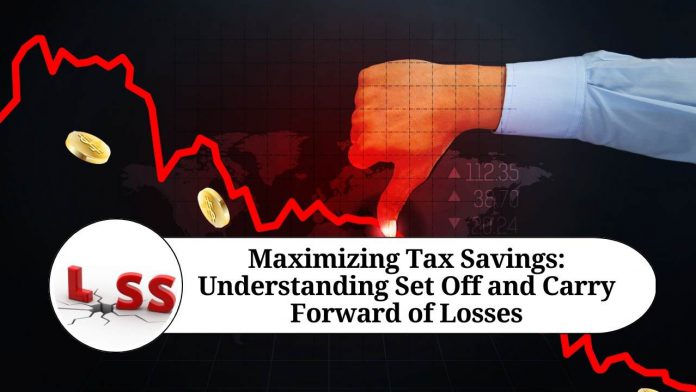When it comes to running a business or investing, it’s not uncommon to experience losses. However, the good news is that these losses can be carried forward to offset future profits, reducing the tax burden on the business or investor. In this blog, we will explore the concept of set off and carry forward of losses.
Set Off of Losses
When a business or investor incurs a loss in a particular year, the income tax laws allow them to set off the loss against any other income earned during that year. This means that the losses can be used to reduce the taxable income of the business or investor, resulting in a lower tax liability.
For example, let’s say a business has a loss of $10,000 in a particular year and earns $50,000 in other income. The business can use the loss to offset the other income, resulting in a taxable income of $40,000. This reduces the tax liability of the business and helps them save money.
Carry Forward of Losses
Sometimes, the losses incurred in a particular year are so high that they cannot be fully set off against the income earned in that year. In such cases, the income tax laws allow the losses to be carried forward to future years for set off against profits earned in those years.
The period for which the losses can be carried forward varies for different types of losses and is subject to certain conditions. In general, the losses can be carried forward for up to 8 years in most cases.
For example, let’s say a business incurs a loss of $50,000 in a particular year and earns no other income. Since the loss cannot be set off against any other income, the entire loss can be carried forward to future years for set off against future profits. Let’s say in the next year, the business earns a profit of $30,000. In this case, the carried forward loss of $50,000 can be set off against the profit of $30,000, resulting in a net loss of $20,000 that can be carried forward to the next year.
Types of Losses
There are different types of losses that can be set off and carried forward. These include:
Business Loss: A business loss is a loss incurred by a business or profession. It can be set off against any other income of the business or carried forward to future years.
Capital Loss: A capital loss is a loss incurred on the sale of a capital asset, such as land, building, shares, or securities. It can be set off against capital gains made during the same year or carried forward to future years for set off against future capital gains.
Speculation Loss: A speculation loss is a loss incurred on the purchase or sale of securities in the stock market. It can be set off only against speculation income earned in the same year or carried forward to future years for set off against future speculation income.
House Property Loss: A house property loss is a loss incurred on the ownership of a house property, such as interest paid on home loans. It can be set off against any other income of the taxpayer or carried forward to future years.
Conditions for Set Off and Carry Forward:
There are certain conditions that must be met in order to set off and carry forward losses. These include:
The loss must be incurred in the same financial year for set off against other income of the taxpayer.
The loss must be related to the same source of income for carry forward to future years.
The taxpayer must file their income tax returns on time to be eligible to carry forward losses.
The loss must be supported by proper documentation and accounting records.
The taxpayer must not have any unabsorbed depreciation or capital expenditure to be eligible for carry forward of losses.
Limitations on Set Off and Carry Forward
There are certain limitations on the set off and carry forward of losses, such as:
Losses can only be set off against income that is taxable under the Income Tax Act.
The amount of loss that can be set off or carried forward is subject to certain limits and restrictions.
Losses can only be carried forward for a specific number of years, depending on the type of loss.
The carry forward of losses is not allowed in case of a change in the ownership of a business or profession.
Other Useful Links:
- Section 194IB of Income Tax Act
- Section 194J of Income Tax Act
- Section 194K of Income Tax Act
- Section 194N of Income Tax Act
- Section 194O of Income Tax Act
- Section 195 of Income Tax Act
Conclusion
The set off and carry forward of losses is an important aspect of the Income Tax Act that helps taxpayers reduce their tax liability. By using losses to offset profits, taxpayers can save money and invest in growth opportunities. It’s important to understand the rules and regulations governing the set off and carry forward of losses to ensure compliance with the tax laws. Taxpayers can seek the help of a professional tax consultant to understand the provisions and implications of the set off and carry forward of losses.\
Frequently Ask Question
Q:1 What is the difference between set off and carry forward of losses?
A: Set off of losses means that losses incurred in a particular year can be used to reduce taxable income in the same year, while carry forward of losses means that losses incurred in a particular year can be carried forward to future years to set off against future profits.
Q:2 Which types of losses can be carried forward?
A: Business losses, capital losses, speculation losses, and house property losses can be carried forward to future years.
Q:3 How long can losses be carried forward?
A: The period for which losses can be carried forward varies for different types of losses and is subject to certain conditions. In general, the losses can be carried forward for up to 8 years in most cases.
Q:4 Can losses be set off against any income?
A: No, losses can only be set off against income that is taxable under the Income Tax Act.
Q:5 Can losses be set off against losses incurred in different sources of income?
A: No, losses can only be set off against the same source of income. For example, a business loss can only be set off against business income.
Q:6 Can losses be carried forward in case of a change in the ownership of a business?
A: No, losses cannot be carried forward in case of a change in the ownership of a business or profession.
Q:7 Is there a limit on the amount of loss that can be set off or carried forward?
A: Yes, there are certain limits and restrictions on the amount of loss that can be set off or carried forward, depending on the type of loss.
Q:8 Do I need to file my income tax returns on time to be eligible for carry forward of losses?
A: Yes, taxpayers must file their income tax returns on time to be eligible to carry forward losses.
Q:9 Can I get professional help in understanding the set off and carry forward of losses?
A: Yes, taxpayers can seek the help of a professional tax consultant to understand the provisions and implications of the set off and carry forward of losses.




















